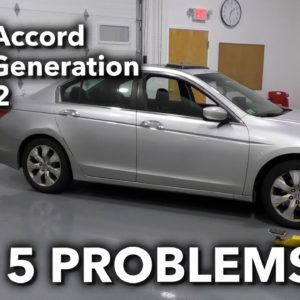In this video, I'm gonna be going over the
top five problems on this eighth-generation Honda Accord. Now, there's nothing wrong with this vehicle,
there's nothing wrong with buying one or owning one. These are the top five problems that we have
found. Every vehicle has their problems. Number one, the alternator. The alternator is located right here at the
front of the motor. It's attached to the drive belt.
Now, the alternator's job is to maintain the
charge of the battery. Some of the symptoms you may notice while
you're driving the vehicle, the vehicle could all of a sudden stall. Hopefully, the battery light comes on on the
dash first so that it gives you a little bit of warning, but if it stalls and then the
vehicle won't start, the battery's dead, most likely the alternator wasn't charging the
battery and that's what killed the battery. So if that's the case, you're gonna need to
charge the battery and you may need to replace the battery before you change the alternator. To replace the alternator, you're definitely
are gonna want to disconnect the battery. You can take the belt off and to gain access,
get anything that's in your way out of the way.
There'll be bolts holding the alternator to
the engine block, and then you have to disconnect the cables as well. Number two, ignition coils. Now, the coils are located right here and
there'll be some on the backside because this is a V6 model. If you have the four-cylinder model, there
should just be a strip in the middle. Now, the coil is actually attached to the
spark plug, that's how you get your spark. And if one of these coils fails, then you're
gonna end up with a misfire. So the engine will be shaking. You'll have a check engine light. Most likely it'll be a flashing check engine
light with a P0300 through P0306. To replace the coil, you're gonna disconnect
the connector and then take the nut off. Slide the coil out and slide the new coil
in. Now, whenever you're replacing coils, it's
always a good idea to replace the plugs as well. Number three, the crankshaft position sensor. The sensors are located right here underneath
this plate. Now, this happens to be the V6 model.
It may be different on a four-cylinder engine. Some of the symptoms you may notice if the
sensor is bad, you might end up with a check engine light, but you may also have a stalling
condition or a no-start condition. With the no-start condition, the vehicle will
crank, but it won't start. To replace the sensor, you're gonna take these
bolts out, take this cover out of the way, disconnect the connector, and then there should
be a bolt holding on that sensor. Take that bolt out, put the new sensor in,
and after you're all done, you are gonna have to do a relearn procedure, which you can do
with a scan tool. Number four, the catalytic converters. Because this is the V6, you have one located
right here in front of that O2 sensor and you have one in the front as well. So when you have a bad catalytic converter,
most likely the first thing you're gonna notice is a check engine light with a P0420 or P0430. And that's basically the computer monitoring
what the converter is doing.

And if it's not performing its job properly,
then you're going to get that code. One of the other symptoms you may notice is
poor acceleration. You may be able to accelerate slowly and that's
fine, but if you try to do a heavy acceleration, you're not gonna be able to move very quickly. Now, when you get that code, there is a couple
of things you want to check. You want to make sure you don't have any exhaust
leaks, and on the intake side, you want to make sure there's no intake leaks. If everything else checks out, chances are
you need a converter and you're gonna replace it. There's some nuts down below here you have
to take off and there's some nuts top. Take those off and replace the gaskets as
well. Now, one way you can prevent this is make
sure you do routine tune-ups. Replace the spark plugs. If you don't change the spark plugs regularly,
or if you have a bad coil and raw fuel is going into the converter, it's gonna heat
up and cause it to plug up, and then you're gonna have to replace it.
Number five, the blower motor. The blower motor is located underneath the
glove box on the passenger side. There is a cover over it you'd have to remove
that cover to access it. Now, the blower motor is gonna come on when
you turn your HVAC on, when your turn your heating and air conditioning on. And when you increase the speed, that is what
is pushing the air through the system. Now, you may notice if the blower motor itself
is making a loud noise, that could be an indication that it's gonna need to be replaced soon,
or if it's not working at all if you turn the heat on or AC and nothing's coming out
of any of the vents. To replace the blower motor, you're going
to need to take this panel off. There should be some screws that hold the
blower motor in, and also an electrical connector.
Disconnect that, swap the new one in, you
should be good to go. So those are the top five problems that we
found on this Honda Accord. If you enjoyed this video, make sure you subscribe
to our channel, ring the bell, turn on all notifications so you don't miss any of our
videos..

